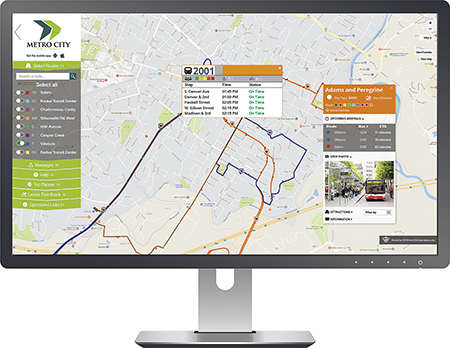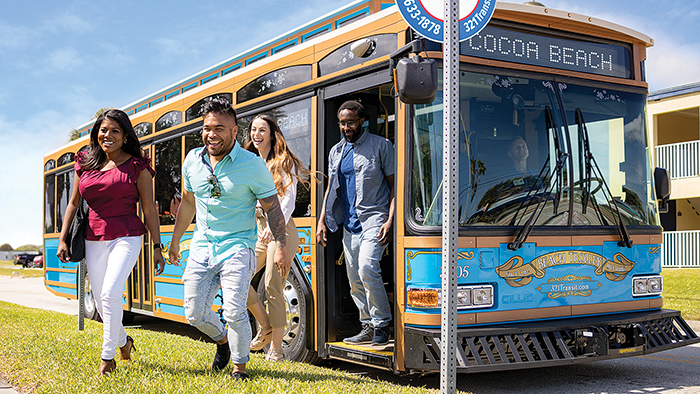
Terry Jordan, director of Space Coast Area Transit in Brevard County, Florida, said the agency has embraced cutting-edge transit technology for years.
“Even before my time as interim director and director of the County’s Transit Service Department, our agency has sought to implement technology to help us capture information under the guidance of prior director, Scott Nelson, and many members of our dedicated staff,” he said. “We have desired to have actionable information which we can best utilize to make service improvements and adjustments, as well as having accurate data for day-to-day operations.”
Jordan said that although a full-scale Intelligent Transportation System (ITS) project has been on Space Coast Area Transit’s radar for a few years, the project very recently advanced to the implementation and integration stages.
“When I came on board three years ago, I was able to help move the project along, working with various individuals in the agency to gain input,” he said. “It was crucial to include our demand-response operations and take their desires and needs into consideration.”
While the agency dedicates most of its 72 buses to 23 daily fixed routes, Jordan said an equal amount of consideration was given to the paratransit and “contract routes” during the ITS planning process.
On Space Coast Area Transit’s contract routes, 35- and 40-foot buses provide daily transportation for specially designated passengers to medical and adult training centers/Seniors at Lunch and again later in the day to return home. This sort of fixed-route/paratransit hybridization is somewhat unique to Space Coast, Jordan said.
Space Coast Area Transit’s ITS deployment covers three main areas: passenger data, vehicle and route data, and passenger information. Integrating all three areas required an advanced coordination tool in an open architecture. Enter ETA Transit and its cloud-hosted ITS system, SPOT™.
“We had been visiting with Space Coast Area Transit for several years,” said John Maglio, president, and chief technology officer for ETA Transit. “One of the bedrock principles of our corporate mission is to develop strong relationships with potential transit partners to understand their challenges better and innovative those solutions that address their critical issues.”
 Since 2003, ETA Transit has been at the forefront of cloud-hosted intelligent transit technology—one of the earliest to embrace a shift from the legacy, site-based server systems that have long-held an advantage over the ITS market.
Since 2003, ETA Transit has been at the forefront of cloud-hosted intelligent transit technology—one of the earliest to embrace a shift from the legacy, site-based server systems that have long-held an advantage over the ITS market.
ETA’s SPOT™ system – or Spatial Positioning on Transit – is a modular tool in an open architecture environment, designed to deliver solutions based on an agency’s unique needs at a lower cost than most legacy systems. At its fullest potential, SPOT can provide CAD/AVL capabilities, powerful back-office software, passenger information systems, intelligent route management, and support for GTFS
and GTFS-RT.
“Early on, we understood that Space Coast Area Transit wasn’t a run-of-the-mill transit agency,” Maglio said. “They had a vision, which paved the way for highly constructive and collaborative discussions.
We worked very closely with Mr. Jordan, shared some of the innovations we were working on, and he provided some fantastic insights that not only helped to refine the nature of Space Coast Area Transit’s needs but led to improvements to our overall system.”
“From our perspective, Space Coast Area Transit represents what we look for in a potential customer,” Maglio added. “They did more than issue an RFP. They were transparent with their business and technology requirements; they were open to new ideas and information, and willing to look at their project from multiple viewpoints.”
Maglio noted that the Space Coast Area Transit’s contract was never a ‘sure thing.’
“Frankly, in this business, one never knows if it has the inside track or not,” he said. “The best you can do is sit down with customers, take an active interest in their success, and do your best to demonstrate how they will be better off with your solution. Our best customers are those who have allowed us to take their journey with them and evaluate the entirety of their situation, not just a bottom line.”
Space Coast Area Transit understood this and awarded ETA Transit the contract in 2020.

Within a week of the notice to proceed, Maglio said that ETA created a portal for Space Coast Area Transit, populated with route information from its GTFS data. Within 90 days, ETA completed deployment of its onboard systems on the fleet and conducted stationary testing with agency planners.
Jordan said Space Coast Area Transit uses SPOT™ internally to manage vehicle location and gain real-time data from the many connected transit systems that the agency has pushed out to fixed-route service.
 APC
APC
Jordan said that automated passenger counting (APC) is a critical tool for Space Coast’s ridership data.
“When we would go out to upgrade bus stops with new benches, shelters, and amenities, we were previously relying on anecdotal information from drivers,” he said. Now they evaluate ridership at each stop with complete precision.
“SPOT™ lets us know where to invest and where we can allocate dollars,” he said. “Where is the highest ridership? Which route segments require some adjustments to make bus travel easier?” Space Coast Area Transit’s staff can read data for any period – whether by day, week, month, or year. Access to this information provides the agency with a valuable tool for planning purposes and service improvements.
AVL
Jordan said that Automatic Vehicle Location (AVL) is vital for safety within Space Coast Area Transit’s system. During an emergency event, the operations team can readily access vehicle location data for safety and security purposes, drilling down to precise details using an easy-to-use map interface.
In the past, the agency might have had to rely on calling drivers directly. Now the AVL pings automatically every 10 seconds, constantly providing Space Coast Area Transit with real-time data.
“We know where the buses are at all times via GPS map, or we can query a specific vehicle,” he said. “We can see exactly the speed of each vehicle, the exact location concerning its route, when it has stopped, and if it is showing a longer-than-normal dwell time. If there is an incident aboard one of our vehicles, we will know where to find it.”
Space Coast Area Transit drivers also make full use of the AVL system. In past years, drivers starting their shifts would sit outside the agency’s main transit center and wait for their bus to arrive. Today, the SPOT™ AVL system connects to monitors in the drivers’ lounge, dispatch center, and the Space Coast-branded 321 Transit App – all readily accessible for drivers.
Passenger Information
The 321 Transit App links AVL information directly to Space Coast Area Transit, providing passengers with the real-time vehicle and trip information they need. With the push of a few buttons, customers can download the app and see the exact location of their bus – a massive upgrade over the agency’s traditional paper schedules.
“The app is invaluable in the hot Florida weather, where waiting a few extra minutes indoors can make a big difference,” Jordan said. “If there is a delay on a bus, riders can stay abreast of that information and time their trip accordingly.”
Jordan said the app enjoys high usage among passengers and represents a great “selling point” for using public transportation.
Beyond the passenger-facing app, the SPOT™ system provides automated vehicle announcements (AVA) for passengers while en route. The system pushes out notifications such as safety warnings, ADA-specific information, or mask reminders. These announcements are triggered based on a predefined schedule, the vehicle’s location, or providing stop-specific information to interested passengers.
A final part of the SPOT™ project involved deploying soon-to-come solar-powered ePaper displays to Space Coast Area Transit bus stops.
“Unlike traditional signage, these displays can provide real-time information without the need for constant electrical power or expensive infrastructure,” Maglio said. “This aligns nicely with Space Coast Area Transit and their many green initiatives.”
 Demand-Response
Demand-Response
Space Coast is fine-tuning the implementation for the demand-response team, bringing the agency’s paratransit operation from paper-and-pencil to an all-digital interface. The system will automatically generate data for demand-response drivers by shifting from paper manifests to digital tablets, including pick-up and drop-off times, mileage, trip length, and more.
When Space Coast Area Transit flips the proverbial switch on its new paratransit system, passengers will receive automated calls reminding them a day before their trip and again just before the vehicle’s arrival.
“We are very hopeful that this will not only improve the accuracy of our information but also reduce passenger no-shows or inordinate wait times,” Jordan said.
SPOT™
All these features flow back to SPOT™, which provides Space Coast Area Transit with the ability to view, analyze, and manipulate data to improve service quickly. Its primary benefits are route creation, data collection, and real-time status updates, but the capability to expand is perhaps SPOT’s most intriguing feature.
Maglio said that beyond its CAD/AVL capabilities, SPOT™ integrates seamlessly with passenger counters and the agency’s mobile video surveillance system through an ETA-provided mobile broadband router. SPOT utilizes commercial off-the-shelf hardware, which Maglio said makes it much more affordable than legacy systems with similar features.

“The onboard computers we provided to Space Coast Area Transit are powerful, rugged devices built with expandability in mind,” Maglio said. For example, Maglio said that ETA sees a shift in transit where many agencies have begun to upgrade onboard announcements to onboard infotainment systems. If Space Coast Area Transit ever opts to upgrade to a full-scale infotainment system with ETA, the agency already owns the hardware required to do so.
“It is important and unique that the system is upgradeable and expandable without incurring future hardware costs,” Maglio said.
Space Coast Area Transit also utilizes SPOT’s self-service analytics module, allowing staff to create and share custom dashboards when generating reports and presenting data.
“Internally, we primarily use the SPOT™ console to see real-time information about our buses, including speed, location, and the number of passengers,” Jordan said. “The AVL works great for making announcements and keeping our dispatchers on top of vehicle location.”
Passengers have been very enthusiastic about both the app and automated announcements at community outreach events, where agency representatives have helped educate riders about in-app features of which they might not have been aware.
“Just by word of mouth, passengers know about the app and have expressed happiness with using it,” he said. “So far, it has been successful.”
The system’s cloud-based nature bodes well for upgrades and future changes. As Jordan puts it, the system constantly collects large loads of data on ridership, vehicle location, and more. Without the ability to keep this data in the cloud, server storage would quickly become cumbersome.
“The cloud-based nature is also important for accessibility,” he said. “Our staff can readily and quickly access this information, but so can ETA and our other vendors who might need access to certain analytics – and all in real-time.”
Maglio said that ETA and Space Coast Area Transit are embracing changes to the transit marketplace and preparing for future changes.
“System integration under open standards is the way forward for transit,” he said. “We see so many disruptions in the industry, from microtransit to MaaS, and even autonomous vehicles. As a technology provider, we need to be in tune with these marketplace-changing factors. And it is a pleasure to partner with agencies like Space Coast Area Transit which embrace new ideas.”
